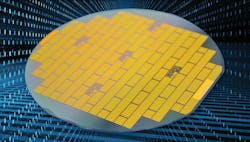Researchers approach industry for ultrawide-bandgap semiconductors in military radar and communications
ARLINGTON, Va. – U.S. military researchers are asking industry to develop new kinds of integrated circuit substrates, device layers, junctions, and low-resistance electrical contacts for a new generation of ultrawide-bandgap semiconductors.
Officials of the U.S. Defense Advanced Research Projects Agency (DARPA) in Arlington, Va., issued a broad agency announcement earlier this month (HR001123S0051) for the Ultra-Wide BandGap Semiconductors (UWBGS) project.
Ultrawide-bandgap technology represents a new class of semiconductors for future applications of RF and high-power electronics, deep-ultraviolet electro-optics, quantum electronics, and systems that must operate in harsh environments.
Experts in the DARPA Microsystems Technology Office are interested in two kinds of ultrawide-bandgap devices: low-defect-density substrates larger than 100 millimeters in diameter; and device layers with high doping efficiency abrupt homo- and hetero-junctions with low junction defect density and ultralow-resistance electrical contacts.
Ultrawide-bandgap materials like aluminum nitride, cubic boron nitride, and diamond have the potential to revolutionize semiconductor electronics for applications like high-power RF switches and limiters; high-power-density RF amplifiers for radar and communications systems; high-voltage switches for power electronics; high-temperature electronics and sensors for extreme environments; deep-ultraviolet light emitting diodes (LEDs); and lasers, DARPA researchers say.
Yet today's poor quality of ultrawide-bandgap materials limit their performance, and scientists must overcome several technical challenges to bring this technology to fruition.
The three-year UWBGS program seeks to improve the material quality of device layers and junctions, and improve the electrical quality of metal contacts. To do this, the project focuses on three areas: large-area ultrawide-bandgap substrates; dopants for ultrawide-bandgap materials for ultrawide-bandgap homo-and hetero-junctions; and blending ultralow-resistance electrical contacts and ultrawide-bandgap materials.
Companies interested should submit abstracts no later than 1 Nov. 2023 and full proposals no later than 15 Dec. 2023 to the DARPA BAA website online at https://baa.darpa.mil. Several contract awards are expected, and the program is scheduled to begin in July 2024.
Email questions and concerns to DARPA's Thomas Kazior at [email protected]. More information is online at https://sam.gov/opp/3b75e7b92317410a9850686d7b724517/view.
About the Author
John Keller
Editor-in-Chief
John Keller is the Editor-in-Chief, Military & Aerospace Electronics Magazine--provides extensive coverage and analysis of enabling electronics and optoelectronic technologies in military, space and commercial aviation applications. John has been a member of the Military & Aerospace Electronics staff since 1989 and chief editor since 1995.
